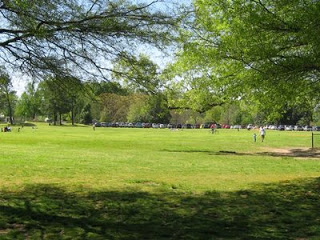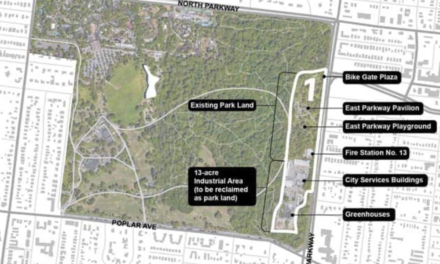Note: The Citizens to Preserve Overton Park and Get Off Our Lawn (GOOL) are raising $4,000 in support of the upcoming shuttle trial from the Overton Square parking garage to Overton Park. The amount includes the $2,000 that the Memphis Zoo had promised but has since revoked.
Please contribute at https://www.ioby.org/project/overton-park-shuttle
It’s always uncomfortable – if not painful – to watch two friends fight with each other.
The only thing worse is when three friends do it, and that’s certainly what’s happening at Overton Park with the Memphis Zoo, Overton Park Conservancy, and Citizens to Preserve Overton Park. Come to think of it, there’s a fourth entity in this controversy: City of Memphis.
In other words, there are a lot of smart people involved in this debate, and surely, with all this brain power, there is a solution that can defuse this controversy and point the way to the future.
That said, surely, everyone can agree to a fundamental principle that should be an anchor value for city government: parks are not parking lots.
Cars, Not Again?
It seems that for decades, Memphians have been protecting Overton Park from cars, dating back to the early 1970s when park lovers fought to prevent the interstate from plowing through it. It resulted in the landmark U.S. Supreme Court decision that set out the rule that federal highways can only be built through parks if all other reasonable alternatives have been exhausted.
With that rich history in mind, what are the reasonable options for providing parking for zoo-goers without putting cars on the Greensward? We understand that some park lovers are more opposed than we are to a shuttle running on interior park roads from a parking area on the east side of the park (note: we have heard from many people we respect, including Stacey Greenberg – see her comment below – about the problems with shuttles inside the park and the disruption to the bike infrastructure; their arguments are persuasive).
The solution that seems to be gaining ground is a parking garage. Memphis operates on a mindset that parking should be close and convenient so the Zoo’s suggestion for a parking garage seems consistent with that attitude. The best location for it is in the maintenance off N. Parkway at the former eastern entrance to the zoo that so many of us used when we were kids. Any other location runs the risk – unless the garage is underground – of it becoming an eyesore similar to the garage at Memphis International Airports.
Memphis Mayor A C Wharton said the 400-space, four-level garage would cost $5 million and city administration officials said they would not contribute to its construction. Zoo officials estimate the cost of a 600-space garage at $12-15 million, which includes cleaning up and moving the zoo maintenance area. As a point of reference, the Overton Square garage cost $16 million for 435 spaces but it included the cost of a one million cubic feet detention basin under it.
First Things First
We hope city officials will reconsider their position on garage funding, because if a garage is the ultimate solution, it would also benefit park users who are rediscovering the park under the thoughtful management of the Conservancy. The mayor is right when he said that parking on the Greensward is not the “highest and best use” for the parkland, but we think that it is in the highest and best interest of City of Memphis to participate in a funding solution that brings this conflict to a close.
While we are admirers of the photography of William Eggleston, one of Memphis’s great artistic talents, we assume that the cost of moving the General Services maintenance facility on the eastern side of Overton Park to provide a site for the Eggleston Museum is not minor. At this point, addressing the current opportunities and challenges, perhaps, the museum, if it wants space in Overton Park, should be directed to a location in the area of the existing art museum and art college – or a location at Audubon Park. That would allow City of Memphis to reallocate the money for the move of the maintenance facilities to solving the immediate challenge of a garage solution. (Note: see comment that says that Eggleston Museum supporters have agreed to pay these costs.)
The people on all sides seem passionate about their points of view, but truth be told, we have been surprised by the attitude of zoo officials, which has alternated between petulant and insulting and hyperbolic. If there was one well-deserved skill that these officials have shown time after time over the years, it has been their professional demeanor and the interest in serving the broad interest of Memphis. In this case, however, their frustration, if not pique, is showing by their petty decision to withdraw funding for a shuttle that would take people from the Overton Square garage to the zoo and the park and by statements that seem to ignore other users to the park and the reality of an even busier future for Overton Park.
So far, the Overton Park Conservancy, which has taken the right position in setting its goal as removing cars from the Greensward, has shown admirable maturity for a new organization in its efforts to mediate the various interests and to identify a solution. We assume that a similar level of maturity and patience will be exhibited by all sides if an answer can be reached expediently and if a plan to implement can begin quickly.
Parks Aren’t Parking Lots
Meanwhile, the Citizens to Preserve Overton Park continues its role as advocates for the park’s potential, and based on its effective and correct opposition to the city engineer’s plans to turn the Greensward into a deep drainage basin, it would seem that everyone involved in this current issue would have realized that the days for parking on the Greensward were coming to an end.
We know that overflow parking for the zoo has been on the Greensward for several decades, but we also understand that the accelerating green ethos in Memphis is shaping our quality of life and the priorities that shape it. It’s often hard to realize that Memphis is short order has become home to an active, influential movement creating bike lanes, greenlines, pedestrian/bike paths, and high quality parks with Shelby Farms Park and Overton Park.
As city government considers the implementation of Jeff Speck’s recommendation that would transform Riverside Drive into a two-lane street so a bike lane can be added and parking can be moved out of Tom Lee Park, it seems reasonable that its position is to bring the same attitude toward Overton Park. As Mr. Speck said in advocating for the change, real urban parks don’t have parking in them. No one is advocating that all parking should be removed from Overton Park, but it seems logical that it is not expanded to turn an Olmstead Park into a parking lot.
As the parties in this dispute work toward a solution, it’s worth remembering that the public’s #1 priority, according to Sustainable Shelby, is for local government to create a great public realm. It’s hard for us to think of any place in Memphis that more exemplifies quality public realm than Overton Park.
A Monument to Memphis’s Progress
In addition, Overton Park is a 342-acre monument to the late 19th century “Greater Memphis Movement,” when our city was the national leader of the Progressive Era with the design of Memphis’ landmark parks and parkways system. Memphis quadrupled its size in 1899 when it annexed seven square miles.
John Olmsted, nephew and adopted son of the legendary Frederick Law Olmsted Sr., father of New York’s Central Park, was hired to lay out new parks but he said, after touring Memphis on a bicycle, that because of the growth of Memphis, it should develop two large parks, one on the river south of the city and the other at the eastern border connected by a system of parkways.
As a result, City of Memphis purchased about 342 acres of on old farm tract called Lea’s Woods, which became the early Overton Park, and 340 acres on the Mississippi River which became Riverside Park. In the end, the complex and ambitious Memphis project included the redesign and development of three of the city’s four original 1819 squares; the design of three new small urban parks, including Forrest, Confederate, and Gaston Parks; the design and development of Overton and Riverside Parks; and the design for the new system of parkways to connect these parks and spur development in the newly annexed areas.
From the beginning, it was clear that Overton Park had a special place in the hearts of Memphians. It’s a connection that continues to this day, as evidenced by the current debate about parking on the Greensward.






Your excellent piece mistates one item. The proposed Eggleston museum has agreed with the City to pay all costs to relocate the City from the entire 16 acre parcel now occupied by General Services at Poplar and East Parkway. This includes the cost of demolition of all structures and remediation of all environmental damage and the cost to restore the entire parcel to public green space, with the museum’s site kept north of the existing entranceway. These costs further include, by agreement with the zoo, relocating its two greenhouses now operating in the heart of the maintenance premises.
The zoo needs adjacency for both visitors and maintenance. Any new garage would thus include or otherwise accommodate maintenance at its current location within zoo confines.
The US Supreme Court case you site required the FHA to exhaust all reasonable alternatives to destroying public parkland. Here, using public parkland soon to be restored as public green space for yet another maintenance yard–especially one on the other side of the park from the zoo and reached by its trucks and staff only by city streets–cannot possibly be in anyone’s best interest, not even the zoo’s.
Thank you for the thoughtful piece and your support. When you say, “We are willing to support a shuttle running on interior park roads from a parking area on the east side of the park” please consider that these interior roads have been closed to cars/motorized traffic for over 20 years. These interior roads are used by pedestrians (and their dogs), runners, bicyclists, children, etc.regularly. This area is the only car free zone in Midtown. A shuttle/tram/whatever would be a VERY unwelcome sight, even more unwelcome than cars on the Greensward. If the Zoo chooses to use the east side for temporary parking until the Eggleston museum is built, then they need to ask their visitors to walk (through the lovely interior roads like hundreds/thousands of other park users do every weekend) or drive their shuttles around the park on city roads.
At 6:00 p.m. on Wednesday, July 16, the Memphis Chapter of the Kessler Society will meet at the Overton Park Club House Patio to celebrate the contributions of George Kessler for the third consecutive year. It will be Kessler’s 152 birthday (and last year Ida B. Wells was also celebrated as she and Kessler share the same birth day and year – July 16, 1862).
George Kessler is the architect for Overton Park, Riverside Park (now Dr. Martin Luther king, Jr. Park) and the Parkway system which connected them. He had won the contract from the newly formed Memphis Park Commission that was following the lead and recommendation of the Olmstead Brothers for expanding park land in Memphis. Kessler was the leading landscape architect in America at that time designing Kansas City’s park system, the Louisiana Purchase Exposition in St. Louis (World’s Fair now Forest Park) and many other parks in other cities, as well as Gaston, Forrest, Confederate and Bickford parks in Memphis.
Join Roy Barnes (Citizens To Preserve Overton Park member & local Kessler Society president), Jimmy Ogle (Shelby County Historian & CPOP member) and Bob Loeb (Overton Square developer and Overton Park lover) for some enlightening conversation and fellowship on the prettiest patio spot in Memphis!
Thank you.
Thanks so much for the added insight. We heard from several people pleading the case for the interior roads to be reserved for pedestrians and bikes, and it is a persuasive case.
PS: We have added notes in the blog post that readers should read these comments about the museum and the shuttle inside the park.
Thanks again for sending.
Jimmy: Thanks for all that you do to remind us daily about how rich our history is and why places like Overton Park are so important to who we are as a community and to our future.
I appreciate the willingness of Smart City to amend its post re: the Eggleston project, but SCM has neglected to address the other point made in the poster’s comment. How can it be helpful to the wider goal of a green Memphis to edge out a museum committed to a use of its space much more in line with the spirit of Overton Park for a parking garage?
Harvey: Thanks for the comment. We were trying not to get into the weeds too much on the museum since it’s an entirely different issue. Our preference is for that space to be returned as parkland use and the museum consider a different location.
Fair enough. De gustibus non est disputandum. But, as I value the opinion of SCM on this issue, would you be willing to go into why you think that a parking garage qualifies as parkland use and the museum doesn’t?: Forgive me if these two sentences seem contradictory.
We don’t think a parking garage should be built where the General Services maintenance area is either.
That is helpful. After rereading your article, I can see where I may have assumed you were advocating for a parking garage when in fact it does not appear to be the case. I am still puzzled about where you are heading logically in advocating for the Eggleston museum to be displaced by a different use of that space (a use that I am apparently not grasping currently), but I grant that I am dealing with higher minds at this point.
We’re not even suggesting that a garage should be considered except where the former east entrance of the zoo once was. We also think that unless that garage is underground, it’s going to be pretty jarring in the park.
Higher minds are always good to deal with.
Can anybody tell me why Eggleston gets to pick its place in the park in the first place? It’s owned by the public, not by the big boys.
First, how many parking spaces are needed? How many do we have at present? Why do we talk about “parking garages” when “parking decks” are cheaper if they can satisfy the demand. The airport, until it built the new “parking garage” was committed to “parking decks” for several decades and the cost savings were significant. Decks can be built over existing facilities without having to find more land.
I too find myself admiring the maturity being displayed by the OPC as both advocate and mediator. I wish the Zoo would regain its collective composure and address this issue with a new perspective- one that does not involve the Zoo as the center point around which Overton Park, its collection of uses and the rest of Midtown by default should be so honored to orbit.
I am still confused as to how the organization behind the zoo failed to see the approach of this tipping point. Limited parking has plagued the zoo for many years. During this period, fund raising campaigns have been nearly continuous in the Zoo’s honorable pursuit of better facilities to be enjoyed by the citizens of this city and region. Why is it the zoo has managed to time and time again make room for expanded facilities, new exhibits and redesigned features and yet not included a solution to their parking woes as part of their long range facility plan?
Considering the odd, almost haphazard layout of the existing surface lot in front of the zoo, I questions whether a more efficient layout would increase both the number of spaces as well as provide improved safety for those walking to the entry plaza.
There is also the issue of what can only be described as amusement park rides and dilapidated structures along the northern and eastern sections of the facility. What place do these rather run down activities have as part of a world class zoo? Perhaps the zoo should weigh rather such ancillary uses are occupying space that could be better utilized. Parking should obviously be considered in decision making.
In the end, I am a bit surprised by the brouhaha. I thought the Zoo had already stated a desire for a controlled parking deck or garage as a solution to its parking woes. A partial deck over portions of its existing lot, properly treated with earthen berms and extensive landscaping would do much to alleviate existing parking issues with minimum impact on the aesthetic qualities of the surrounding parkland. I can imagine a gently sloping hill rising on the northern fringe of the greensward that would obscure any view of such a structure.